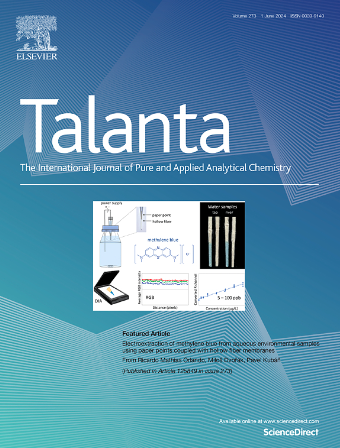Ultrasensitive and smart trace detection via interface-enhanced multi-phonon resonance Raman scattering
IF 5.6
1区 化学
Q1 CHEMISTRY, ANALYTICAL
引用次数: 0
Abstract
Trace detection technology has important applications in fields such as biomedicine, food safety, and environmental monitoring. However, it currently faces challenges including insufficient sensitivity, low efficiency, and a need for improved personalized services, which seriously hinder the in-depth development and widespread application of trace detection technology. Herein, a metal/semiconductor heterojunction was designed and constructed. The synergistic effects of interfacial charge transfer and interfacial passivation of anion vacancy defect states density were revealed to significantly enhance the intensity of multi-phonon resonance Raman scattering (MRRS) of the semiconductor with an enhancement factor of up to 1.4 × 109. A MRRS detection platform was developed to achieve a detection limit of 8.5 aM for let-7a and a relatively wide linear range from 50 aM to 100 nM. Compared to conventional semiconductor detection platforms, the heterojunction probes reduced the detection limit by three orders of magnitude, and expanded the linear range by five orders of magnitude. Furthermore, the enhanced synergistic effect at the heterojunction interface directly boosts the MRRS signal intensity, significantly lowering the detection limit, and broadening the linear range. To further improve detection efficiency and user experience, this technology was combined with smartphone intelligent analysis software, allowing for rapid reading and intelligent analysis of MRRS data from serum sample, which enhances the speed and accuracy of data processing. This work not only offers a new, ultrasensitive approach to develop trace detection technology, but also makes significant strides in improving personalized services and promoting the advancement of telemedicine.

痕量检测技术在生物医学、食品安全和环境监测等领域有着重要的应用。然而,目前痕量检测技术面临着灵敏度不够、效率不高、个性化服务有待提高等挑战,严重阻碍了痕量检测技术的深入发展和广泛应用。本文设计并构建了一种金属/半导体异质结。结果表明,界面电荷转移和阴离子空位缺陷态密度的界面钝化协同作用显著增强了半导体的多声子共振拉曼散射(MRRS)强度,增强因子高达 1.4 × 109。所开发的 MRRS 检测平台使 let-7a 的检测限达到 8.5 aM,线性范围从 50 aM 到 100 nM。与传统的半导体检测平台相比,异质结探针将检测限降低了三个数量级,将线性范围扩大了五个数量级。此外,异质结界面上增强的协同效应直接提高了 MRRS 信号强度,大大降低了检测限,并扩大了线性范围。为进一步提高检测效率和用户体验,该技术与智能手机智能分析软件相结合,实现了对血清样本 MRRS 数据的快速读取和智能分析,提高了数据处理的速度和准确性。这项工作不仅为开发痕量检测技术提供了一种全新的超灵敏方法,而且在改善个性化服务和促进远程医疗发展方面取得了重大进展。
本文章由计算机程序翻译,如有差异,请以英文原文为准。
求助全文
约1分钟内获得全文
求助全文
来源期刊

Talanta
化学-分析化学
CiteScore
12.30
自引率
4.90%
发文量
861
审稿时长
29 days
期刊介绍:
Talanta provides a forum for the publication of original research papers, short communications, and critical reviews in all branches of pure and applied analytical chemistry. Papers are evaluated based on established guidelines, including the fundamental nature of the study, scientific novelty, substantial improvement or advantage over existing technology or methods, and demonstrated analytical applicability. Original research papers on fundamental studies, and on novel sensor and instrumentation developments, are encouraged. Novel or improved applications in areas such as clinical and biological chemistry, environmental analysis, geochemistry, materials science and engineering, and analytical platforms for omics development are welcome.
Analytical performance of methods should be determined, including interference and matrix effects, and methods should be validated by comparison with a standard method, or analysis of a certified reference material. Simple spiking recoveries may not be sufficient. The developed method should especially comprise information on selectivity, sensitivity, detection limits, accuracy, and reliability. However, applying official validation or robustness studies to a routine method or technique does not necessarily constitute novelty. Proper statistical treatment of the data should be provided. Relevant literature should be cited, including related publications by the authors, and authors should discuss how their proposed methodology compares with previously reported methods.
 求助内容:
求助内容: 应助结果提醒方式:
应助结果提醒方式:


